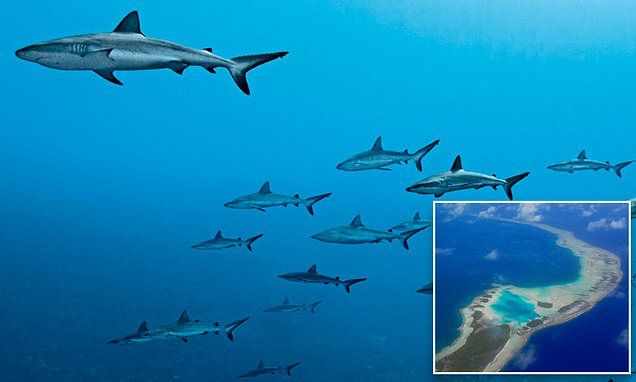
Scientists found gray reef sharks near French Polynesia nap by power surfing on currents' updrafts
Researchers have found gray reef sharks in French Polynesia are able to save energy by surfing the updrafts of the currents in the area.Experts at Florida International University found that the sharks, located in Fakarava Atoll, can save up to 15 percent of their normal energy expenditure by floating and relaxing on the current.'During the day, they're pretty placid and relaxed, swimming with minimal effort,' FIU marine scientist Yannis Papastamatiou said in a statement. 'It's interesting because it's a pretty strong current.' While conducting their research, Papastamatiou and the other researchers saw 'hundreds' of gray reef sharks swimming against the current.Gray reef sharks in French Polynesia can save energy by surfing the updrafts of the currents in the areaThe sharks, located in Fakarava Atoll, can save up to 15 percent of their normal energy expenditure by floating and relaxing on the currentFakavra Atoll is a popular diving spot in the Pacific Ocean and the second-largest of the Tuamotu atollsTo save the most energy, the sharks changed how deep they went to surf the current. For incoming tides with strong updrafts, they went deeper, while they were closer to the surface for outgoing tidesThe sharks also created a 'conveyer-belt-like system,' in which one shark that reached the end of the line allowed the current to bring it back to the beginningThey also noted the sharks had created a 'conveyer-belt-like system,' in which one shark that reached the end of the line allowed the current to bring it back to the beginning.After they saw other sharks also do that, did the experts realize they were on to something. 'This study is a nice demonstration of energy seascapes, a spatial representation of how much energy it costs an animal to move through an environment,' Papastamatiou added. 'Marine environments are a lot more dynamic because of the water currents, which are much less predictable. They can change seasonally, throughout the day and even minute by minute. Ultimately, the energy seascape helps explains why these animals are in this channel hanging out there during the day. Now we have an answer.' Fakarava is a famous dive site and home to approximately 500 gray reef sharks, which have been known to attack humans. To save the most amount of energy, the sharks changed how deep they went to surf the current.For incoming tides with strong updrafts, they went deeper, while they were closer to the surface for outgoing tides. The scientists used a number of tools, including tracking tags and cameras to make their observations. These findings could also apply to other coastal areas, and possibly explain why there may be larger numbers of sharks in certain places. It could even help predict why sharks may prefer one area over another. The research was recently published in Journal of Animal Ecology. Although much smaller than other sharks such as gray whites, these agile predators can reach over 6ft in length and can be spotted by their white-tipped dorsal fins, broad snouts and large eyes.They normally reside near coral reefs and have been spotted as far west as South Africa.In July 2020, researchers found that shark populations have gone missing from nearly 20 percent of the world's coral reefs. One month later, a separate study was published that found that after hunting at night, gray reef sharks return to the same spot on the reefs and stayed in a stable group of other gray reef sharks.
……Read full article on Daily Mail
Animals Ocean News
Comments
Leave a comment in Nestia App